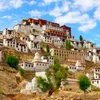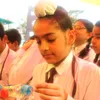‘What you imagine is even more important than what you see’ – creative insights from Art Bengaluru 2019
In Part II of our photo essay on the ninth edition of this festival, we feature a range of artworks along with tips and advice from the exhibiting artists.
Launched in 2014, PhotoSparks is a weekly feature from YourStory, with photographs that celebrate the spirit of creativity and innovation. In the earlier 400 posts, we featured an art festival, cartoon gallery. world music festival, telecom expo, millets fair, climate change expo, wildlife conference, startup festival, Diwali rangoli, and jazz festival.

Free for all visitors to attend, the month-long Art Bengaluru festival in UB City is featuring 200 works by 21 artists from across the world, See Part I of our photo showcase here, along with artist insights from RM Palaniappan (Chennai) and Afra Khan (Jeddah).
The festival includes over a dozen talks, workshops, curated walks, and other art experiences, such as a performance by the Bangalore City Chamber Orchestra. It also features Film Bengaluru, an international film festival on the theme Kindness Matters, organised in partnership with the UNESCO MGIEP (Mahatma Gandhi Institute of Education for Peace and Sustainable Development).
“Everything I see, feel, think and absorb has made me become a creative person. It is important to accept the realities in life and be true to oneself. Art has given me that strength and also opened up multi-dimensional ways of seeing any situation and responding consciously,” says Bengaluru artist Rekha Krishnamurthy, in a chat with YourStory.
Rekha graduated from the College of Fine Arts, Chithrakala Parishath and Ken School of Art, Bengaluru. She has won the Shenoy Art Foundation Award and Mysore Dasara Mahothsava Kala Mela Uphasamithi Award.
She has also helped curate exhibitions at the National Gallery of Modern Art, Bengaluru, Kochi Muziris Biennale, and Artville Contemporary Gallery, Bengaluru. “If my art works are able to reach another person’s eye, that is also success for me,” Rekha explains.
“The Indian art scene is struggling today; the country’s economic conditions also reflect in the commercial galleries. This is a challenge for upcoming and emerging artists,” she cautions. To improve art appreciation in India, she recommends that art should be seen as much more than just a recreational activity in schools.
“Aesthetic values should be instilled from the roots. This moulds and strengthens the foundation of a human being, and that impact will reflect on our society as well,” Rekha explains.
At the exhibition, she displayed a series of photographs mirroring the places she travelled to, along with memories and even negative emotions evoked while immersing in them. Her art works are priced around Rs 1 lakh, with variations depending on materials, size, theme, and time spent. Rekha says she appreciated viewers who spent time viewing each work and reading the accompanying text, and even taking selfies.
Rekha advises audiences to not judge an artwork only by its appearance. “Art is not about just what it looks like or is made up of. Each time you look at it, based on your state of mind, the painting can revert to your feelings and gradually you will be able to build an emotional connect with it,” she says.
“Aspiring artists should continually practice and never give up. Eventually they will be able to reach their destined success. That’s what I do, take it slow and easy,” she advises.
“I just like to look at each artwork individually to see what it does to me. I prefer artworks that blow me away even before I know the true intent of the artist,” explains Dutch artist Daan Oude Elferink. He loves going to art festivals and art fairs where it is possible to see so many creative and beautiful artworks in one place.
“Over the past eleven years, I have been exploring and photographing abandoned places all over the world. I fell in love with the excitement, but most of all with the beauty of decay,” he says. He often has to go to the extreme to get into these places, some of which are off limits to the public.
“When a beautiful place is well preserved, I look at it, enjoy it for a moment, and then forget about it. But when a place is abandoned and decayed, it tells a story. It ignites the imagination. How did these people live? Why did they leave? What happened? In my artwork, I intend to trigger that same imagination,” Daan explains.
He is a self-taught photographer, and has experimented with a range of materials and finishes (such as matt, glossy or metal). “My new photos are way more soft and natural than the early ones. Locations I skipped in the past because ‘they were just empty ruins’ are nowadays often my favorite locations,” Daan adds.
His works are exhibited in about 15 different countries every year, including cities like Miami, New York, London, Hong Kong, Stockholm, Dubai and Paris. This is his second time being featured at Art Bengaluru.
“In the last eleven years, I have created about 275 different artworks, of which many are not available anymore, because they have a limited edition of only eight pieces of all sizes together,” Daan explains.
He also gives presentations and talks about his work. “I don’t give workshops. What I do is dangerous and I don’t want to inspire others to take the same risks as I do. I just want to inspire them to find their own passion and creativity,” he clarifies.
Daan defines success as getting appreciation, honour and exhibition requests – more than just making money. “Of course, it is great that my artwork is sold well in many countries, because that makes it possible for me to do what I do. But I truly feel I am successful when I get appreciation about my work,” Daan says, citing an incident when a woman from Sweden phoned him. “She said: ‘I just wanted to say: Thank you for what you do.’ For me that’s goosebumps all over,” Daan enthuses.
He is also an author, and his third book, Touched by Time, was awarded a prize by the FEB (Federation of European Photographers) in Catania, Sicily. Three of his mini-artworks will be displayed in the ‘Miniature Museum of Contemporary Art’ in The Netherlands, along with the works of other great artists.
Daan’s works at Art Bengaluru are priced from Rs 70,000 to Rs 5.5 lakh. One of his big eight-metre artworks called ‘Garden of Eden’ is displayed at the entrance to UB City.
“The reason why the curator of the festival and I choose this particular piece, is because he told me that Bangalore was once called ‘The Garden City’, but that green cover slowly got taken over by architectural structures,” Daan explains. “My artwork ‘Garden of Eden’ is exactly the opposite. When you give nature the opportunity, it eventually takes it all back,” he says.
These days, Daan spends each week finding abandoned places in Europe for short day trips. His next trip is to Japan, and he is also working on a book project which includes VR glasses to create an immersive experience.
“Art is an emotion. It is personal. Just look at a work of art and experience it. Some artworks will give you nothing, others will make you happy, or completely the opposite. Sometimes there is a deeper meaning to an artwork, and sometimes there isn’t,” Daan advises audiences.
“What you imagine is even more important than what you see. And everybody sees something different,” he explains.
He also offers tips for aspiring artists. “Be yourself even though others tell you to be different. Don’t be tempted to change your art for commercial reasons, because you might lose your passion. Artwork is not about money, but about emotion,” Daan signs off.
Now, what have you done today to pause in your busy schedule, and find ways to creatively and positively harness your inner energy?



















Rekha Krishnamurthy




Daan Oude Elferink
Got a creative photograph to share? Email us at [email protected]!
See also the YourStory pocketbook ‘Proverbs and Quotes for Entrepreneurs: A World of Inspiration for Startups,’ accessible as apps for Apple and Android devices.









![[Weekly funding roundup Jan 4-10] VC inflow shows steady rise](https://images.yourstory.com/cs/2/220356402d6d11e9aa979329348d4c3e/funding-lead-image-1669386008401.jpg?mode=crop&crop=faces&ar=1%3A1&format=auto&w=1920&q=75)